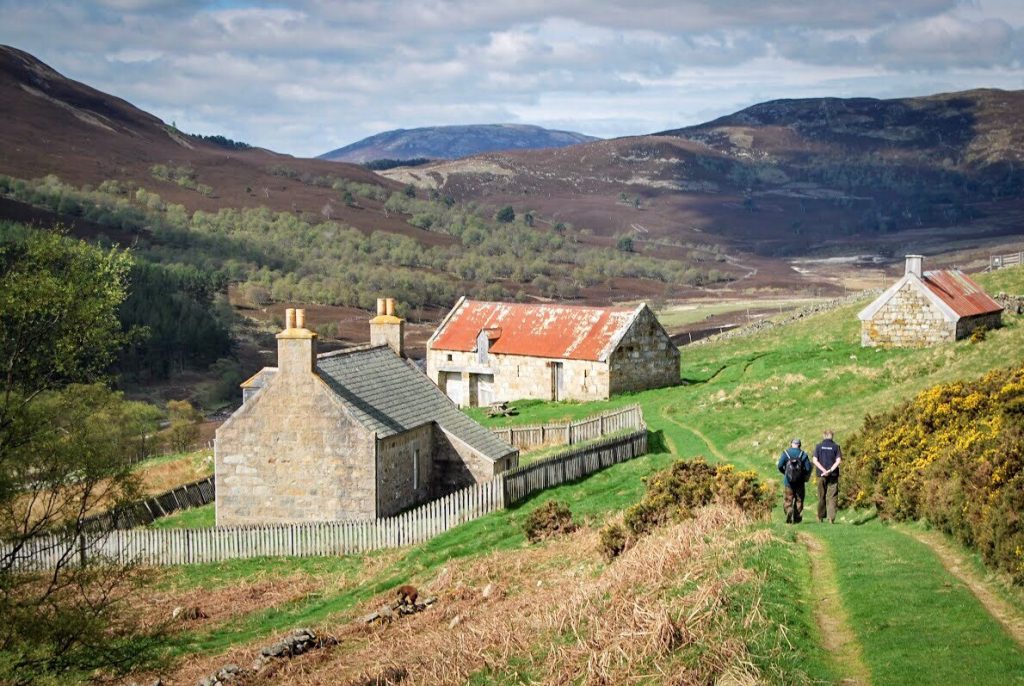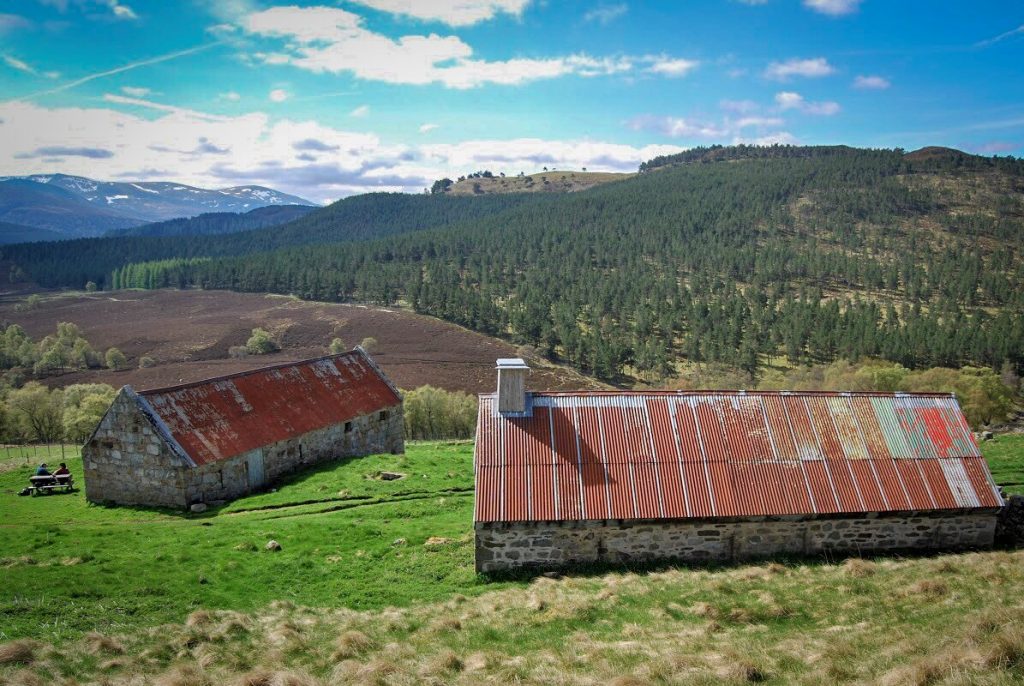Thatch Detectives: Searching for Scotland’s Thatched Buildings
Conservation, Vernacular and earth building | Written by: Stephanie Weinraub | Wednesday 23 May 2018

The location of Hingin’ Lum Cottage at Auchtavan is beautiful, but remote. It took local guidance, along with a four-wheel-drive and a hike, to locate and record it for the survey.
It takes determination to survey a thatched building that can only be accessed with five miles of four-wheel-driving up into the hills, followed by a half-mile trek across the uplands of Deeside…
…but determination is what we’re armed with! Along with a camera, notepad, and a local guide with 25 years’ knowledge and experience of the area.

The Hingin’ Lum Cottage at Auchtavan is a traditional cruck-framed stone building. It has a heather-thatch hiding preserved under its newer roof of cheery red tin. It was conserved in 2008 and is maintained as a museum by Braemar Community Ltd.
Discovering Scotland’s thatched buildings
In 2014-15, Historic Environment Scotland (HES) funded a survey, carried out by the Society for the Protection of Ancient Buildings (SPAB) Scotland.
The survey was designed to seek out and record every thatched building in Scotland.
The effort was successful. It identified around 250 of the thatched buildings that remain. What’s more, it highlighted the importance this increasingly rare building form has for traditional Scottish heritage.
But of course, conducting the survey also showed the gaps in our knowledge. Some of the buildings were known about but couldn’t be located using the data available.
What’s more, after the release of the survey, some individuals came forward to flag up thatched buildings that HES and SPAB weren’t aware of. These buildings were missed out in the survey. So, as was expected from the outset, there was more work to be done on recording Scotland’s thatch!
Tracking down thatched buildings is tough business
This is why a follow-up survey has been commissioned. It aims to track down the buildings that couldn’t be found the first time around, or that have come to light since.
So this project is hardly a stroll down the road with a camera and a notepad, ticking buildings off an orderly list. These are the elusive ones, the ones hiding in the hills or under corrugated iron…
…or both, in this case! This is why I have headed up to Aberdeenshire with Zoe Herbert, an architectural consultant, in search of more thatched buildings.
As the Traditional Skills and Materials Intern, my role is to assist with the survey as much as I can, but mostly I’m along to learn more about this increasingly rare, and definitely traditional, material.
Zoe Herbert carried out the first survey, so she has a lot of experience and knowledge of these types of buildings!
In many ways, this tough business of tracking-down is characteristic of the very buildings we’re trying to find.
The buildings we’re looking for – vernacular, rural, traditional – often date from a time when settlement patterns were quite different to what they are today.

Often traditional thatched roofs were covered over by corrugated iron, a more practical and durable roofing material. Sometimes entire thatched roofs have been preserved in this way, protected against deterioration. These can be very valuable for the evidence they provide, and for the age of the thatched roof – hidden gems waiting to be found!
The spread of rural communities
Today, the places we make our homes are usually dictated by car access up paved roads, and connectivity to services such as electricity, water, and broadband.
Before the creation of the car, settlement was more evenly spread across the countryside. Many places we consider remote today would perhaps have had resident communities.
This is certainly true of Auchtavan. A few standing buildings and lots of archaeology indicate a community of perhaps a dozen families. These families farmed and milled corn and burned lime in the hills above the River Dee until around a hundred years ago.
The so-called Hingin’ Lum Cottage, with its heather thatch, is now the only traditional house left standing. It’s evidence for the ways of life that once existed here.
For all these reasons, the second survey will undoubtedly be more difficult than the first. The site visits themselves are being carried out over the next month.

The Hingin’ Lum Cottage (right) and a cruck-framed horse mill (left) are the only standing buildings left of Auchtavan’s small community. Together they form an educational site for local groups, and for any visitors intrepid enough to reach them.
Preparation is the key
We’ve had to do a great deal of preparation, including:
- Identifying correct locations using local knowledge or satellite images
- Getting permissions to for access and photography
- Liaising with local community members or landowners who can often contribute greatly to our knowledge about the buildings
All these measures have been in preparation for months. This will help make sure that the survey will be as effective as possible.
In some ways it really is like detective work. You can’t always know what you don’t know! But hopefully, through diligent research and with the help of community members, we’ll be able to track down the rest of Scotland’s thatched buildings.
Can you help us find Scotland’s hidden thatch buildings?
You can help our efforts to record and preserve Scotland’s traditional buildings!
Do you know of a thatched building that the survey may be missing? Get in touch with the Technical Research team at technicalresearch@hes.scot.
And remember, sometimes thatch can be hidden under later tin roofs.
Learn more
For more resources on thatched buildings, visit:
About the author:
Stephanie Weinraub
Stephanie Weinraub was a Technical Conservation Skills Project Officer at Historic Environment Scotland. Stephanie is interested in all elements of traditional craft and materials, but she specifically focuses on thatch, plasterwork, and earth construction. She loves “reading” buildings, and has an unashamed fondness for castles.
View all posts by Stephanie Weinraub



